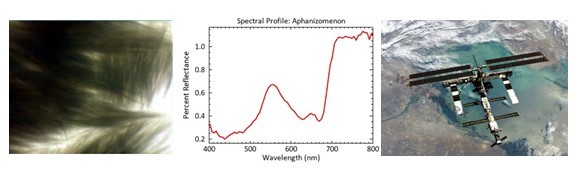Cyanobacterial blooms in eutrophic inland waters are a worldwide concern. Blooms are exacerbated by high nutrient inputs and warmer waters and have been appearing with increasing frequency in water bodies used for drinking water or recreation. This problem will likely worsen as the climate warms. Cyanobacterial blooms are a nuisance for their unsightly surface scums and the production of taste-and-odor compounds, and some strains of cyanobacteria produce toxins which are hazardous to human and animal health. Simple and fast detection methods would greatly aid water managers in issuing proper warnings for harmful algae. Remote sensing has been used to detect cyanobacterial blooms, but few studies have distinguished between genera of cyanobacteria. Because some genera are more likely to be toxic than others, this is a useful distinction. Earlier studies have employed imaging spectroscopy at the microscope level to explore and develop spectral signatures. In this study, hyperspectral imaging reflectance microscopy at the National Institute for Standards and Technology (NIST) and hyperspectral satellite imaging from the the National Aeronautical and Space Administration (NASA) DESIS (DLR Earth Sensing Imaging Spectrometer) are being used to examine hyperspectral imaging of cyanobacteria from several freshwater lakes in the United States. At high spatial and spectral resolution, unique spectral and imaging profiles of common algal blooms, like Aphanizomenon flos aqua, can be identified and analyzed spectrally. Of the analytical methods applied, a spectral shape algorithm applied to the derivative was found to be most successful in classifying genera in hyperspectral scenes.

Left: the Image from the NIST Hyperspectral Microscope of the common algal bloom, Aphanizomenon flos-aquae, with FOV approximately 2-millimeters across. Middle: The spectroscopic profile obtained from both the hyperspectral microscope and, Right: The DESIS hyperspectral sensor on the The International Space Station. Photos from USGS and NASA.

